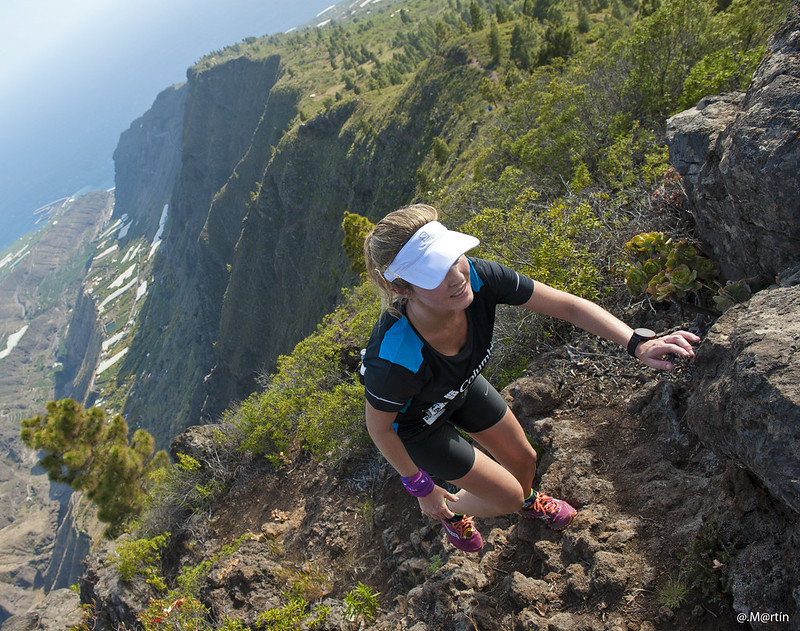In trail running or orienteering people say that if you have to run 100 m of elevation up and down it would take the same time as running flat for 1000 m. We can find a similar old rule of thumb and more recently, some researchers added a little science to this vernacular knowledge (Davey, Hayes, and Norman 1994; Scarf 2007) but with few data points (2 athletes and 300 race results, respectively).
Could we add some modern massive data to check this saying? Using our dataset scraped from ITRA on 16 949 race results from 2 802 runners (download), we can fit a basic non linear model to estimate the parameters:
results <-read.csv("results.csv")(model <- results |>nls(hours ~ (dist_tot + deniv_tot / k) / v, data = _,start =list(k =100, v =8)))
Nonlinear regression model
model: hours ~ (dist_tot + deniv_tot/k)/v
data: results
k v
87.267 9.564
residual sum-of-squares: 313645
Number of iterations to convergence: 3
Achieved convergence tolerance: 1.289e-06
(ic <-confint(model))
2.5% 97.5%
k 81.697567 93.327303
v 9.331476 9.809111
So we see that the average flat speed sustainable over a long period of our sample (which is biased towards elite runners) is around 9.6 km⋅h-1 and that 1 km flat is equivalent to 87 m [82 – 93] of height gain, not far from the old 100 m. Of course these values will vary according the athlete shape, the total race length and profile and many other parameters…
References
Davey, R. C., M. Hayes, and J. M. Norman. 1994. “Running Uphill: An Experimental Result and Its Applications.”The Journal of the Operational Research Society 45 (1): 25. https://doi.org/10.2307/2583947.
Scarf, Philip. 2007. “Route Choice in Mountain Navigation, Naismith’s Rule, and the Equivalence of Distance and Climb.”Journal of Sports Sciences 25 (6): 719–26. https://doi.org/10.1080/02640410600874906.
Source Code
---title: "Does 100 m equal 1 km?"description: "Climbing or not climbing?"author: "Michaël"date: "2021-09-16"date-modified: last-modifiedcategories: - R - sportdraft: falsefreeze: trueeditor_options: chunk_output_type: consolechunk_output_type: console---[{fig-alt="A photo of a runner climbing on a trail during Transvulcania 2016"}](https://flic.kr/p/GQUgPu)In trail running or orienteering people say that if you have to run 100 m of elevation up and down it would take the same time as running flat for 1000 m. We can find a similar old [rule of thumb](https://en.wikipedia.org/wiki/Naismith%27s_rule) and more recently, some researchers added a little science to this vernacular knowledge [@DaveyRunninguphillexperimental1994; @ScarfRoutechoicemountain2007] but with few data points (2 athletes and 300 race results, respectively).Could we add some modern massive data to check this saying? Using our [dataset scraped from ITRA](/2020/08/10/trail-running-is-it-worth-starting/) on **16 949 race results from 2 802 runners** ([download](results.csv)), we can fit a basic non linear model to estimate the parameters:```{r}results <-read.csv("results.csv")(model <- results |>nls(hours ~ (dist_tot + deniv_tot / k) / v, data = _,start =list(k =100, v =8)))``````{r}(ic <-confint(model))```So we see that the average flat speed sustainable over a long period of our sample (which is biased towards elite runners) is around `r round(coefficients(model)["v"], 1)` km⋅h^-1^ and that **1 km flat is equivalent to `r round(coefficients(model)["k"])` m \[`r round(ic[1])` -- `r round(ic[3])`\] of height gain**, not far from the old 100 m. Of course these values will vary according the athlete shape, the total race length and profile and many other parameters...